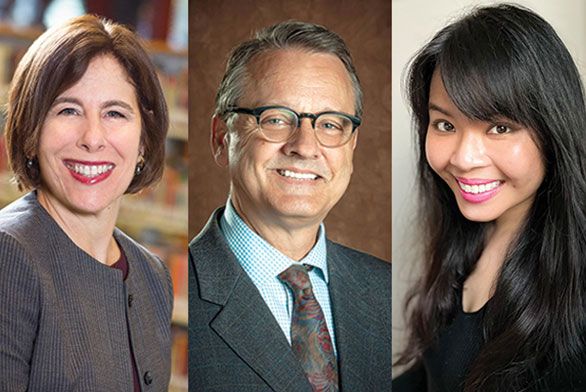Johnnie Librarians Face the Future
December 7, 2023 | By Anne Kniggendorf (SF97)
The book stacks of a library are a familiar and favorite haunt for Johnnies, so it should come as no surprise that many in our community are drawn to careers working in libraries. As society’s common repositories of knowledge, libraries have a certain intellectual and aesthetic charm, but in speaking with Johnnie librarians, there appears to be something in the nature of the work itself that makes St. John’s alumni particularly well-suited to responding to the evolving challenges of the profession.

“The popular conception of libraries is that we are fixed institutions, that we always do things the same, that librarians are just there checking out books and telling you to be quiet,” says Emily Drabinski, president of the American Library Association and critical pedagogy librarian at the Graduate Center at the City University of New York.
“Libraries are always having to deal with the changing world,” she argues. The needs of the patrons, along with the cities and neighborhoods libraries are nestled in, are constantly evolving, necessitating a certain adaptability in those who seek to best serve their communities.
Lisa Rosenblum (A80) worked as the executive director of the King County Library System in Washington state, managing 50 branches and a budget of $140 million before retiring in November 2023. “I always look at the big picture,” she says. “And that might be a St. John’s thing. Why are we doing this? Should we be doing this? Could we do it another way? You can’t just question, though; it’s a combination of questioning but also being outcome- and results-driven.”
Drabinski says, “You have to be sort of nimble enough to change how you do things, and what kinds of materials you collect based on your community. Those things change, but what doesn’t change is the need to build a collection that meets the needs of our community.”
The term “collection” here refers to much more than books. Today’s patrons need a library’s offerings to include government forms, English as a second language courses, career services, technology access, and more.
“It’s not been just about books for a very long time,” says Ron Scrogham (SF93), the dean and director of libraries and research at the Cowan-Blakley Memorial Library at the University of Dallas. He earned master’s degrees in French and Library Science after graduating from St. John’s and has experience working in both public and academic libraries.
Scrogham particularly calls out “UX”—the user experience—a consideration which libraries have borrowed from commercial spaces. He says what librarians “attempt to do is view the entirety of the library and its systems through the perspective of the user. You’re always trying to enhance that, and that lends itself to greater autonomy for the user.”
Where once a librarian worked as a sort of mediator between a patron and sought-after information, the rise of the internet has produced a clientele who are much more adept at doing their own research than they previously were.
Rather than continuing to force an old model, libraries have developed alongside the abilities of those they serve. The not-so-intuitive model of library organization of the past has changed into easily searchable databases similar to internet search engines.
But librarians’ considerations extend beyond the library’s collection and how patrons access information; they also consider the library as a physical, tangible space.
My Nguyen (A09) is a librarian and assistant manager in the DC Public Library system. She didn’t plan on becoming a librarian during her time at St. John’s, though as a teenager she volunteered as a library page for the Central Arkansas Library, the system she grew up using.
As a now-seasoned librarian, she understands that libraries compete with coffee shops and cozy coworking spots to be the so-called “third space” in the lives of community members.
“There’s certainly been a shift from the damp, dusty cinderblock buildings where you feel like you’re in a little cell and studying and learning just seemed more like a grind, not something vibrant and fun,” Nguyen says. What libraries try to offer now are thoughtfully designed spaces filled with natural light and comfortable furniture.
Nguyen suggests, though, that the patrons themselves are largely the same as ones who have always walked through the doors. “The new customer base, in my opinion, looks very much like the old customer base: it’s patrons who are curious and patrons who are dedicated to thriving and learning.”
When called upon to assist community members, a distinctive part of a librarian’s work that changes unpredictably from one patron to the next, Nguyen says she constantly relies on the skills she learned at St. John’s of listening closely and asking clarifying questions to identify the subtexts of what patrons say to serve them best.
“St. John’s has really helped me in being tireless,” Nguyen says. “Rising to the challenge of reading those Great Books at St. John’s was instrumental. It gives you courage; if you can read Kant—maybe not very well—but if you really made a good effort doing something difficult like that, then you can surely try to answer somebody’s obscure reference question.”
Rosenblum agrees that St. John’s pedagogy was instrumental in honing within her the arts of observation and conversation. “If you’re in seminar and you have to stick up for your ideas,” she says, “you must figure out a way you can talk to people that is not condescending, that is positive and gets your message across. I call it reading the room.”
She also has that quintessential Johnnie confidence when approaching topics that are new to her. “I can walk into a room and not know something and say, ‘Okay, I don’t know this, but teach me about it,’” she says.
It is this agility that ensures she, and other Johnnie librarians like her, can continue to meet the needs of their communities through the library, which Rosenblum calls “the most democratic institution we have right now.”

